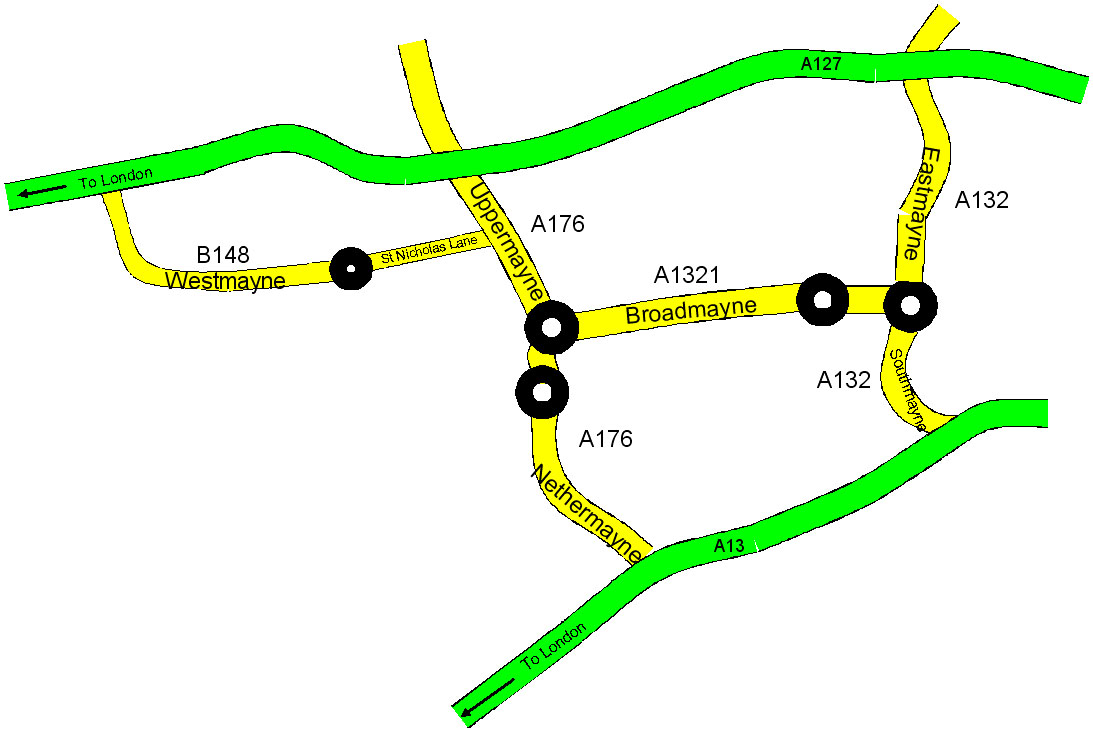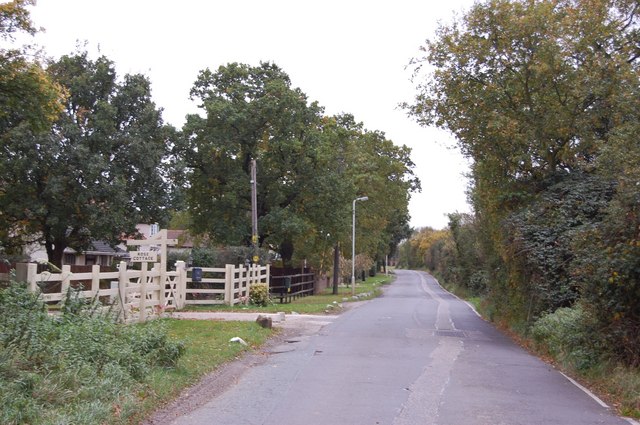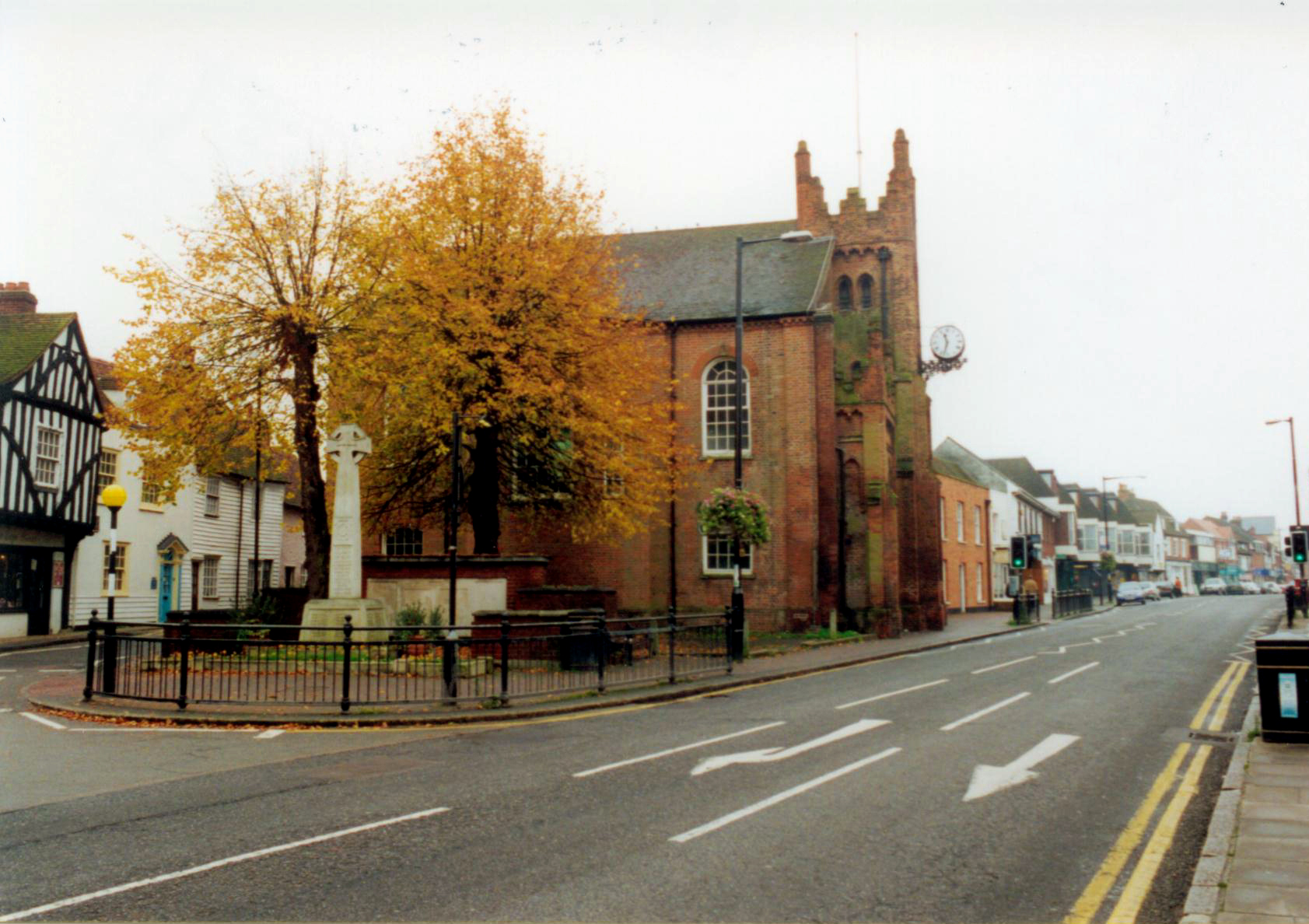|
Laindon
Laindon is a commuter town in Essex, between Basildon and West Horndon. It was an ancient parish in Essex, England, that was abolished for civil purposes in 1937. It was based on the (probably smaller) manor of the same name and now lies mostly within the urban area of Basildon. As of 2020, Laindon's population was 37,175. History The ancient Laindon parish included the chapelry of Basildon that became a civil parish in its own right in 1866. The parish included two detached pieces of coastal grazing land, one of which was on Canvey Island. It included a long finger of land north into the neighbouring parish of Great Burstead to include Laindon Common and the once larger and adjacent Frith Wood which the lord of the manor, the Bishop of London, emparked around 1260. This finger of land may have been the territory of Well Street Manor, which was mentioned in the Domesday Book. Until its abolition in 1937, there was a Laindon parish. It incorporated 412 residents around , in 1831 ... [...More Info...] [...Related Items...] OR: [Wikipedia] [Google] [Baidu] |
Basildon
Basildon ( ) is the largest town in the borough of Basildon, within the county of Essex, England. It has a population of 107,123. In 1931 the parish had a population of 1159. It lies east of Central London, south of the city of Chelmsford and west of Southend-on-Sea. Nearby smaller towns include Billericay to the north-west, Wickford to the north-east and South Benfleet to the south-east. It was created as a new town after World War II in 1948, to accommodate the London population overspill from the conglomeration of four small villages, namely Pitsea, Laindon, Basildon (the most central of the four) and Vange. The local government district of Basildon, which was formed in 1974 and received borough status in 2010, encapsulates a larger area than the town itself; the two neighbouring towns of Billericay and Wickford, as well as rural villages and smaller settlements set among the surrounding countryside, fall within its borders. Basildon Town is one of the most densely populat ... [...More Info...] [...Related Items...] OR: [Wikipedia] [Google] [Baidu] |
London, Tilbury And Southend Line
The London, Tilbury and Southend line, also known as Essex Thameside, is a commuter railway line on the British railway system. It connects Fenchurch Street station, in central London, with destinations in east London and Essex, including , , , , Tilbury, Southend and . Its main users are commuters travelling to and from London, particularly the City of London which is served by Fenchurch Street, and areas in east London including the Docklands financial district via London Underground and Docklands Light Railway connections at and . The line is also heavily used by leisure travellers, as it and its branches serve a number of seaside resorts, shopping areas and countryside destinations. Additionally, the Tilbury Loop portion of the route provides an artery for freight traffic to and from Dagenham Dock and the Tilbury and London Gateway ports. Freight traffic can also travel further using the connection to the Gospel Oak to Barking line and the Great Eastern Main Line at Fores ... [...More Info...] [...Related Items...] OR: [Wikipedia] [Google] [Baidu] |
Laindon Railway Station
Laindon railway station is on the London, Tilbury and Southend line, serving the Laindon area of the borough of Basildon, Essex. It is down the main line from London Fenchurch Street and is situated between to the west and to the east. Its three-letter station code is LAI. It was opened in 1888 on a new direct route from to . The station and all trains serving it are currently operated by c2c. Description The main ticket office is located on Station Approach. It has two serving positions. A second smaller ticket office is located at the bottom of the stairs that lead to two of the platforms, though this is open only on weekdays. The station has three platforms. Platforms 1 and 2 are the two faces of an island platform, accessed via a footbridge from outside the main ticket office. Platform 1 is the London-bound platform and platform 2 is a reversing platform which can be used to divert trains from one line to the other. Platform 3 is the -bound platform, reached from Stati ... [...More Info...] [...Related Items...] OR: [Wikipedia] [Google] [Baidu] |
John Georgiadis
John Alexander Georgiadis (17 July 1939 – 5 January 2021) was a British violinist and conductor. He was twice Concert Leader with the London Symphony Orchestra during the 1960s and 70s, a member of both the ensembles London Virtuosi and the Gabrieli String Quartet as well as conductor for both the Bangkok Symphony Orchestra and the Malaysian Philharmonic Orchestra, and as Director of Orchestral Studies at the Royal Academy of Music. Early life Georgiadis was born in Southend-on-Sea on 17 July 1939, growing up in the nearby town of Laindon. His father Alec was an amateur violinist and encouraged his son to master the instrument from the age of 6. During his childhood on a family holiday to Austria, his family met Willi Boskovsky, who on his visit to England visited and stayed in Laindon giving lessons to the young Georgiadis. He attended the Royal Academy of Music studying with Frederick Grinke and spent a year with René Benedetti. Musical career In the late 1950s, a young Geo ... [...More Info...] [...Related Items...] OR: [Wikipedia] [Google] [Baidu] |
Dunton Wayletts
Dunton Wayletts is a hamlet in the unparished area of Basildon, on the western outskirts of Laindon, in the Borough of Basildon, Essex, England. It is located between the Southend Arterial Road (A127 road) and the London, Tilbury and Southend line. It is usually known as Dunton. Name The name Dunton has Saxon origins ("dun" meaning hill and "tun" meaning town). Wayletts is also derived from the Saxon ("Weylete") and Old English ("Weg-gelaetu") both meaning a place where ways or roads meet. History The earliest reference to Dunton is found in the Domesday Book of 1086 when 'Dantona' was held by Bishop Ode (half brother of William the Conqueror). During the Middle Ages, the parish of Dunton was divided into two manors: Dunton Hall and Fryern Manor. In the 12th century Dunton came under the ownership of the Abbey of Bec-Hellouin. In the 1440s the manor of Dunton was granted to King's College, Cambridge. The manor of Dunton remained in the possession of King's College until well in ... [...More Info...] [...Related Items...] OR: [Wikipedia] [Google] [Baidu] |
Borough Of Basildon
The Borough of Basildon is a Non-metropolitan district, local government district in south Essex in the East of England, centred on the town of Basildon. It was formed as the Basildon District on 1 April 1974 from the former area of Basildon Urban District and the part of Thurrock Urban District that was within the Basildon New Town. The population of the district as of 2010 is about 172,000. The local authority is Basildon Borough Council. The council made an application for Borough status in the United Kingdom, borough status in February 2010 and this was given approval that year, with Mo Larkin becoming the first mayor in October. History The Basildon District was created on 1 April 1974 as part of the local government reorganisation of the Local Government Act 1972. It comprised the former area of the Basildon Urban District and the part of Basildon New Town that had been in Thurrock Urban District. Governance Elections to Basildon Borough Council are held in three out o ... [...More Info...] [...Related Items...] OR: [Wikipedia] [Google] [Baidu] |
Langdon Hills
Langdon Hills is a township and former civil parish located in Basildon in Essex, England. It is located south of Laindon railway station on the London, Tilbury and Southend line. It is the location of the Langdon Hills Country Park, which is in the unitary authority of Thurrock. History In 1767, Arthur Young commented on the view from Langdon Hills :"''…near Horndon, on the summit of a vast hill, one of the most astonishing prospects to be beheld, breaks almost at once upon one of the dark lanes. Such a prodigious valley, everywhere painted with the finest verdure, and intersected with numberless hedges and woods, appears beneath you, that it is past description; the Thames winding thro’ it, full of ships and bounded by the hills of Kent. Nothing can exceed it…''" Until its abolition in 1936, Langdon Hills was a civil parish, part of the Orsett Rural District. From the 1930s the Dunton Plotlands developed and are now commemorated by a museum. In 1931 it covered an ... [...More Info...] [...Related Items...] OR: [Wikipedia] [Google] [Baidu] |
Joan Sims
Irene Joan Marion Sims (9 May 1930 – 27 June 2001) was an English actress, best remembered for her roles in the ''Carry On'' franchise, appearing in 24 of the films (the most for any actress). On television, she is known for playing Gran in ''Till Death Us Do Part'' (1967–1975), Madge Kettlewell in ''Sykes'' (1972–1978), Mrs Wembley, the cook with a liking for sherry, in '' On the Up'' (1990–1992), and Madge Hardcastle in '' As Time Goes By'' (1994–1998). Early life and education Sims was born on 9 May 1930, the only child of John Henry Sims (1888-1964), Station Master of Laindon railway station in Essex, and his wife Gladys Marie Sims, '' née'' Ladbrook (1896-1981). Sims's early interest in being an actress came from living at the railway station. She would often put on performances for waiting passengers. She decided that she wanted to pursue show business during her teens, and soon became a familiar face in a growing number of amateur productions locally. One o ... [...More Info...] [...Related Items...] OR: [Wikipedia] [Google] [Baidu] |
Edgar Longstaffe
Edgar Longstaffe (1852 – 7 December 1933) was a well-known English landscape painter of the Victorian era. Longstaffe was born near Derby in Derbyshire, England. The son of a doctor, he married and moved to Newport, Essex. During the 1880s he exhibited five times at the Royal Academy and at the Royal Hibernian Academy and at Birmingham. A prolific painter, many of his original works, most commonly signed with a monogram but sometimes initialed 'E.L.' or signed 'E Longstaffe', must be in existence today. He was for some years on the staff of Messrs Raphael Tuck & Sons, being sent by them to all the principal beauty spots of the British Isles to obtain sketches for reproduction work in the earlier days of the art picture postcard. He was especially fond of portraying the scenery of the Scottish Highlands, often with cattle, and he excelled in the painting of water. Large numbers of vintage postcards featuring Longstaffe's artwork remain in existence and are frequently to be ... [...More Info...] [...Related Items...] OR: [Wikipedia] [Google] [Baidu] |
Josh James (singer)
Josh James Dubovie (; born 27 November 1990) is a British singer. Dubovie is most notable for having represented the UK at the 2010 Eurovision Song Contest, held in Oslo, Norway, in May 2010, after winning the UK national selection competition with " That Sounds Good to Me", a song by Mike Stock, Pete Waterman and Steve Crosby. Biography Early life Dubovie, from Laindon, performed with StageAbility, an after-school stage club, from age nine. At age 15, he played Enjolras in a school production of ''Les Misérables'' with the Essex Group. For this role he saw a vocal coach as he had no previous experience of singing. He attended The Billericay School and studied for A levels in Music Technology, Drama and English Literature. In 2008 he won the Blues Idol competition, and has also won Voice of St Lukes contest and Billericay's Got Talent. Prior to auditioning for ''Your Country Needs You'', he applied for a part on E4 TV series '' Skins'' 3rd series and was short-listed for ... [...More Info...] [...Related Items...] OR: [Wikipedia] [Google] [Baidu] |
Dunton Plotlands
The Dunton Plotlands was an area of small rural plots of land in Dunton Wayletts, southern Essex inhabited from the 1930s to the 1980s. The 'plotlands' consisted of small plots of land sold in the first half of the 20th century to people who built weekend cottages, holiday bungalows or smallholdings there. Many of the people building weekend cottages here would have come out from London. With the outbreak of the Second World War, many weekenders moved out to their plots on a permanent basis, to escape the worst effects of the Blitz. This period saw the Dunton population at its highest. After the Second World War, the new town of Basildon was created, encompassing the plotlands here and in the surrounding areas of Laindon and Pitsea. At the time, 25000 people lived in the whole area, often with unsurfaced roads and limited water supplies. Dunton Plotlands is situated to the west of Laindon and the Langdon Hills, now on the edge of the Basildon district. Today, Dunton Plotlands ... [...More Info...] [...Related Items...] OR: [Wikipedia] [Google] [Baidu] |
Basildon And Billericay (UK Parliament Constituency)
Basildon and Billericay () is a constituency in Essex represented in the House of Commons of the UK Parliament. Since its 2010 creation it has been represented by John Baron, a Conservative. History The seat was created for the 2010 general election following a review of the Parliamentary representation of Essex by the Boundary Commission for England. It combined parts of the separate, now abolished, Basildon and Billericay constituencies. The election has been won by the Conservative Party by large majorities. Boundaries The Borough of Basildon wards of Billericay East, Billericay West, Burstead, Crouch, Fryerns, Laindon Park, Lee Chapel North and St Martin's. The seat merged about half of the previous constituency of Billericay with smaller parts of the former Basildon Basildon ( ) is the largest town in the borough of Basildon, within the county of Essex, England. It has a population of 107,123. In 1931 the parish had a population of 1159. It lies east of Ce ... [...More Info...] [...Related Items...] OR: [Wikipedia] [Google] [Baidu] |






